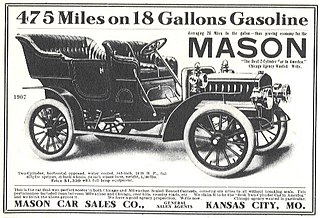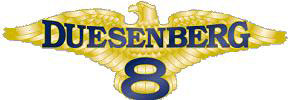
Stoddard-Dayton was a high quality car manufactured by Dayton Motor Car Company in Dayton, Ohio, US, between 1905 and 1913. John W. Stoddard and his son Charles G. Stoddard were the principals in the company.

Stevens-Duryea was an American manufacturer of Veteran and Brass Era automobiles in Chicopee Falls, Massachusetts, between 1901 and 1915 and Vintage Cars from 1919 to 1927.

The Premier Motor Manufacturing Company built the brass era and vintage Premier luxury automobile in Indianapolis, Indiana, from 1903 to 1925.

The Marion was an automobile produced by the Marion Motor Car Company in Indianapolis, Indiana from 1904 to 1915.

Frederick Samuel Duesenberg was a German-born American automobile and engine designer, manufacturer and sportsman who was internationally known as a designer of racecars and racing engines. Duesenberg's engineering expertise influenced the development of the automobile, especially during the 1910s and 1920s. He is credited with introducing an eight-cylinder engine, also known as the Duesenberg Straight-8 engine, and four-wheel hydraulic brakes, a first for American cars, in addition to other mechanical innovations. Duesenberg was also patentholder of his designs for a four-wheel hydraulic brake, an early automatic transmission, and a cooling system, among others. Fred and his younger brother, August "Augie" Duesenberg, shared the patents, filed in 1913 and renewed in 1918, for their "walking beam" four-cylinder engine and the Duesenberg Straight 8.

August Samuel Duesenberg was a German-born American automobile and engine manufacturer who built American racing and racing engines that set speed records at Daytona Beach, Florida, in 1920; won the French Grand Prix in 1921; and won Indianapolis 500-mile races, as well as setting one-hour and 24-hour speed records on the Bonneville Salt Flats in Utah in 1935. He also shared with his older brother, Frederick S. "Fred" Duesenberg, patents filed in 1913 and renewed in 1918 for a four-cylinder engine design and the Duesenberg Straight 8.

Barley Motor Car Co. was a manufacturer of luxury automobiles in Kalamazoo, Michigan, and Streator, Illinois. It manufactured the Roamer automobile (1916–29) and briefly, the Barley (1922–24), and the Pennant (1924–25).
Spaulding was used as an automobile marque by two separate companies. The Spaulding Automobile and Motor Company of Buffalo, New York built Veteran Era automobiles in 1902 and 1903. Spaulding Manufacturing Company of Grinnell, Iowa built Brass Era automobiles from 1910 to 1916.

The Speedwell Motor Car Company was a Brass Era American automobile manufacturing company established by Pierce Davies Schenck that produced cars from 1907 to 1914. The Great Dayton Flood of 1913 greatly damaged the Speedwell factory and inventory, and the company entered receivership in 1915 after having built an estimated 4,000 cars and trucks.
Little Motor Car Company was an automobile manufacturing company founded primarily by William H. Little and William C. Durant that operated from 1911 to 1913. Built in Flint, Michigan, the company was eventually incorporated into the current Chevrolet Motor Company.

Nyberg was the name of a brass era American automobile built by Henry Nyberg of Chicago, Illinois, in Anderson, Indiana, and Chattanooga, Tennessee from 1911 to 1914.

The Matheson was a luxury American automobile manufactured from 1903 to 1912, first in Grand Rapids, Michigan, then Holyoke, Massachusetts and from 1906 in a purpose-built factory in Forty Fort, Wilkes-Barre, Pennsylvania.

Hatfield Motor Vehicle Company was a pioneer brass era American automobile company, built in Miamisburg, Ohio, in 1907 and 1908.

The Parry (1910) and New Parry (1911–1912) were both Brass Era cars built in Indianapolis, Indiana by the Parry Auto Company. During that time, they produced 3500 vehicles. Two cars are known to exist. A Model 40 from 1910 and a Model 41 from 1911.

Willys was a brand name used by Willys–Overland Motors, an American automobile company, founded by John North Willys. It was best known for its design and production of World War II era military jeeps (MBs), Willys M38 and M38A1 military jeeps as well as civilian versions, and branding the 'jeep' military slang-word into the '(Universal) Jeep' marque.
The Halladay Motor Car company was founded in 1905 in Streator, Illinois, and moved to Ohio in 1917.

The Duesenberg Model A was the first automobile in series production to have hydraulic brakes and the first automobile in series production in the United States with a straight-eight engine. Officially known as the Duesenberg Straight Eight, the Model A was first shown in late 1920 in New York City. Production was delayed by substantial changes to the design of the car, including a change in the engine valvetrain from horizontal overhead valves to an overhead camshaft; also during this time, the company had moved its headquarters and factory from New Jersey to Indiana. The Model A was manufactured in Indianapolis, Indiana, from 1921 to 1925 by the Duesenberg Automobiles and Motors Company and from 1925 to 1926 at the same factory by the restructured Duesenberg Motor Company. The successors to the company began referring to the car as the Model A when the Model J was introduced. With a top speed of 71mph.
The Welch Motor Company was an American automobile company headquartered in Chelsea, Michigan. It started in 1901 and continued production of luxury vehicles until 1911 when it merged with General Motors.

The Mason was a Brass Era automobile manufactured in Des Moines, Iowa from 1906 to 1909 and Waterloo, Iowa from 1911 to 1914. In 1909 and 1910 it was marketed as the Maytag-Mason.





















